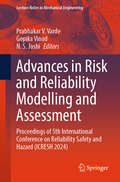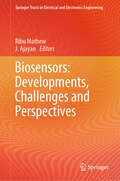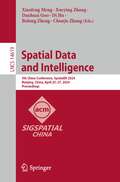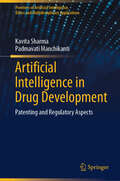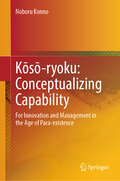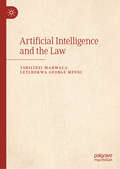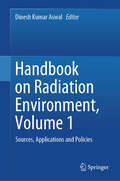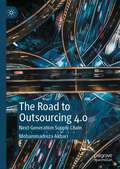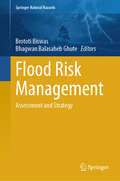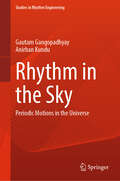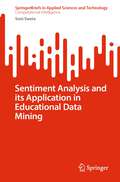- Table View
- List View
Democratizing China’s Political Imaginaries
by Rongxin LiThis book offers a meticulous empirical examination of Chinese democracy and its myriad discourses. Delving into the intricate workings of Chinese democracy, the author explores how the Chinese Communist Party employs democratic principles, how intellectuals grapple with the concept, and how the populace perceives and engages with democracy. In transcending mere methodological nationalism, this narrative extends to the global stage, offering insights into democratic evolution beyond Western paradigms by exploring resonates particularly with developing and post-colonial countries, offering a fresh perspective on the delicate balance between state capacity, social order, and the democratization process. While the trajectory of democracy in China remains uncertain, these empirically grounded analyses provide a pragmatic lens through which to contemplate the future of Chinese political dynamics.
Advances in Risk and Reliability Modelling and Assessment: Proceedings of 5th International Conference on Reliability Safety and Hazard (ICRESH 2024) (Lecture Notes in Mechanical Engineering)
by Prabhakar V. Varde Gopika Vinod N. S. JoshiThis book presents the proceedings of the 5th International Conference on Reliability Safety & Hazard-2024, held in Mumbai during February 21–24, 2024. It covers the latest advances in artificial intelligence and machine learning in development of risk-conscious culture. Various topics covered in this volume are reliability prediction, precursor event analysis, fuzzy reliability, structural reliability, passive system reliability, digital system reliability, risk-informed approach to decision making, dynamic PSA, uncertainty and sensitivity modeling, among others. The book is a valuable resource for researchers and professionals working in both academia and industry in the areas of complex systems, safety-critical systems, and risk-based engineering.
Mental Fatigue Assessment in Demanding Marine Operations
by Houxiang Zhang Thiago Gabriel MonteiroThis book investigates how human mental fatigue (MF) can be objectively measured during demanding maritime operations. The maritime domain is characterized by demanding operations. These operations can be especially complex and dangerous when they require coordination between different maritime vessels and several maritime operators. The best approach to quantify MF is through the use of physiological sensors including electroencephalogram (EEG), electrocardiogram, electromyogram, temperature sensor, and eye tracker can be applied, individually or in conjunction, in order to collect relevant data that can be mapped to an MF scale. More than simpler sensor fusion, this book bridges the gap between relevant sensor data and a quantifiable MF level using both data-driven and model-based approaches. Data-driven part investigates the use of different NNs combined for the MF assessment (MFA) task. Among the different architectures tested, convolutional neural networks (CNN) showed the best performance when dealing with multiple physiological data channels. Optimization was used to improve the performance of CNN in the cross-subject MFA task. Testing different combinations of physiological sensors indicated a setup consisting of EEG sensor only was the best option, due to the trade-off between assessment precision and sensor framework complexity. These two factors are of great importance when considering an MFA system that could be implemented in real-life scenarios. The model-based discussion applies the current knowledge about the use of EEG data to characterize MF to develop an MF approach to quantify the progression of MF in maritime operators. In the research presented in this book, realistic vessel simulators were used as a platform for experimenting with different operational scenarios and sensor setups.
Soft Tissue Simulants (Biomedical Materials for Multi-functional Applications)
by Gurpreet Singh Arnab ChandaSoft tissue simulants, essential for automotive and ballistic testing, medical, and surgical training, have traditionally relied on cadavers and animal tissues. However, their biomechanical properties change with time due to dehydration after death and the biomechanics of the animal models cannot be translated and compared with the human tissues. This book compiles various synthetic tissues used in these applications, addressing their characterization and industry-wide applications. While older simulants lack biofidelity, recent advancements in biofidelic soft tissue simulants offer promising alternatives, yet technology transfer remains limited. This book fills the gap by exploring each simulant's characteristics and current trends, facilitating their adoption in clinical and academic settings. These synthetic tissues have the potential to replace live tissues in surgical training, streamlining biosafety approvals. They also benefit academic researchers by reducing costs and time in biomechanical testing. Anticipated to be the first of its kind, this comprehensive reference book will showcase recent advancements in soft tissue simulant development, serving as a cornerstone text in tissue engineering & biomedical engineering, medical simulation, biomechanics, and related fields.
Biosensors: Developments, Challenges and Perspectives (Springer Tracts in Electrical and Electronics Engineering)
by J. Ajayan Ribu MathewThis book equips its readers with fundamental concepts and a comprehensive understanding of the principle and functionality of biosensors. This book focuses on various biosensor technologies like field effect transistor (FET), plasmonics, bioresorbable biosensors, electro-chemical biosensors, etc., and their applications. The book also covers the reliability aspects and challenges in biosensor development that are a major cause of erroneous calibration and even failure. The book also features the concept of bio receptors, immobilization techniques, target-receptor interactions, surface energy changes, sensitivity, selectivity, etc. This would be an ideal reference for researchers and scholars studying biosensors realized with various material sets and technologies including state-of-the-art modern materials and innovative techniques.
A Love for Nothingness, A Love for Death: The Metaphysics of Desire
by Alberto CastelliThis book aims at explaining romantic love between straight adults through literary texts of the western canon from the nineteenth and twentieth century. Each chapter comes with a multidisciplinary approach in which protagonists are mutilated in their quest for loving as alternative to annihilation. The book emphasizes love as an obsession, thus as an exploration of the mind. From the passion-myth of Tristan and Isolde to the nihilist modernist representations, the western world has created a perverse concept of love. A love for nothingness, for death. Narcissistic and at times destructive, love is gained by overcoming obstacles. If without obstacles there is no love, then love becomes love for obstacles. Within this masochistic frame, love, falling in love, being loved always stand at the edge of pathology. At its core this book narrates a love story, more precisely a story of loves, the haunting evocation of a desire that by its very nature cannot be fulfilled. Inherent in the nature of love is a subtle dialectical activity between presence and absence, between creation and destruction, reality and void. Accordingly, the narrative raises questions that the past two centuries were incapable of answering. Does love only last the time of a kiss? Is its promise fatally destined to dissolve? What about violence? Physical, emotional, temporal. Is it an ineliminable part of love or its most extreme profanation? And what is the mystery that accompanies loves that know how to last without resigning themselves to the death of desire? It is to answer some of these questions that I wrote this text. Love is an unconscious process that dominates reason and destroys it when reason cannot be a mode of communication. Hence, the amorous romance is madness and this text is written as a loud reminder.
Web and Big Data. APWeb-WAIM 2023 International Workshops: KGMA 2023 and SemiBDMA 2023, Wuhan, China, October 6–8, 2023, Proceedings (Communications in Computer and Information Science #2094)
by Jianxin Li Geyong Min Xiangyu Song Ruyi Feng Yunliang ChenThis proceedings constitutes selected papers from the Workshops KGMA and SemiBDMA which were held in conjunction with APWeb-WAIM 2023 which took place in Wuhan, China, during October 6-8, 2023. The 7 full papers included in this book were carefully reviewed and selected from 15 papers submitted to these workshops. They focus on new research approaches on the theory, design, and implementation of data management systems.
Spatial Data and Intelligence: 5th China Conference, SpatialDI 2024, Nanjing, China, April 25–27, 2024, Proceedings (Lecture Notes in Computer Science #14619)
by Xiaofeng Meng Xueying Zhang Bolong Zheng Danhuai Guo Di Hu Chunju ZhangThis book constitutes the refereed post proceedings of the 5th China Conference on Spatial Data and Intelligence, SpatialDI 2024, held in Nanjing, China, during April 25–27, 2024. The 25 full papers included in this book were carefully reviewed and selected from 95 submissions. They were organized in topical sections as follows: Spatiotemporal Data Analysis, Spatiotemporal Data Mining, Spatiotemporal Data Prediction, Remote Sensing Data Classification and Applications of Spatiotemporal Data Mining.
New Advances in Translation Technology: Applications and Pedagogy (New Frontiers in Translation Studies)
by Defeng Li Yuhong Peng Huihui HuangFrom using machine learning to shave seconds off translations, to using natural language processing for accurate real-time translation services, this book covers all the aspects. The world of translation technology is ever-evolving, making the task of staying up to date with the most advanced methods a daunting yet rewarding undertaking. That is why we have edited this book—to provide readers with an up-to-date guide to the new advances in translation technology. In this book, readers can expect to find a comprehensive overview of all the latest developments in the field of translation technology. Not only that, the authors dive into the exciting possibilities of artificial intelligence in translation, exploring its potential to revolutionize the way languages are translated and understood. The authors also explore aspects of the teaching of translation technology. Teaching translation technology to students is essential in ensuring the future of this field. With advances in technology such as machine learning, natural language processing, and artificial intelligence, it is important to equip students with the skills to keep up with the latest developments in the field. This book is the definitive guide to translation technology and all of its associated potential. With chapters written by leading translation technology experts and thought leaders, this book is an essential point of reference for anyone looking to understand the breathtaking potential of translation technology.
Artificial Intelligence in Drug Development: Patenting and Regulatory Aspects (Frontiers of Artificial Intelligence, Ethics and Multidisciplinary Applications)
by Kavita Sharma Padmavati ManchikantiThis book discusses how Artificial Intelligence developments have revolutionized the area of medicine and how companies use them to develop applications. While the book covers the growth of AI in medicine and the early developments in AI based medical tools, it provides an in-depth analysis of the current developments in relation to the area of medical diagnostics. The book focuses on how enterprises and institutes have developed their intellectual property portfolio, particularly patents, in this area. Cross-country patenting analysis helps in understanding key areas of growth in certain markets and also company strategies and arrangements. The introduction of AI based products in market is subject to regulation. The developments in policy and regulation influence the development and deployment of such products into the market. This book brings focus to the development of policy and regulation and how regulatory developments impact the introduction of AI-based healthcare products from a cross-country perspective. Further, how regulatory developments lead to the evolution of standards, build reliability and safety in this area are also examined. The unique aspect of this book is the comprehensive coverage of the dual aspects of the nature and scope of AI-based innovations in health care and the related drug regulatory aspects which are imperative for the understanding for students, researchers, and those who work in this area.
Dynamical Behaviors of Fractional-Order Complex Dynamical Networks
by Jin-Liang WangThis book benefits researchers, engineers, and graduate students in the field of fractional-order complex dynamical networks. Recently, the dynamical behaviors (e.g., passivity, finite-time passivity, synchronization, and finite-time synchronization, etc.) for fractional-order complex networks (FOCNs) have attracted considerable research attention in a wide range of fields, and a variety of valuable results have been reported. In particular, passivity has been extensively used to address the synchronization of FOCNs.
Proceedings of the 14th International Symposium on Computer Science in Sport (Lecture Notes on Data Engineering and Communications Technologies #209)
by Hui Zhang Martin Lames Arnold Baca Yingcai WuThis book is a compilation of selected papers from the 14th International Symposium on Computer Science in Sport (IACSS 2023), held on September 27-30, 2023 in Hangzhou, China. The work focuses on the application of computer science and technology in the field of sports (such as intelligent data collection, data mining, visual analysis of game data, virtual reality, machine learning, computer vision, match prediction models and performance analysis). The contents make valuable contributions to academic researchers, college students, coaches and athletes, and sports management personnel (such as managers of sports associations, training bases, and professional clubs). Additionally, readers will encounter new ideas for realizing a more efficient and convenient training and exercise system.
Kōsō-ryoku: For Innovation and Management in the Age of Para-existence
by Noboru KonnoThis book examines conceptualizing capability (kōsō-ryoku), the most important ability for thriving in the era of innovation. A new approach, "formative conceptualizing capability," is proposed as the core knowledge methodology for innovation and management, which is is a fundamental human ability that goes beyond the boundaries between cognitive and tangible realities to shape concepts and drive innovation. Traditional studies on imagination in Western philosophy are combined with knowledge creation theory based on Eastern way of thinking. The book argues the capability should be at the core of innovation management, offering insights and principles for navigating the challenges of the present age. Japan has experienced the world's earliest capitalist setback and is stuck in a prolonged stagnation. The author maintains, however, that what is needed in this coming chaotic era is not only “imagination”, as it would be called in English, but also the power of creating kōsō, the Japanese term for “formative concept”. The author has a proven track record in research and practice on knowledge creation theory, innovation management, design thinking, and scenario planning. He has reorganized and set forth in this book the perspectives he has proposed under the theme of kōsō-ryoku to present a new methodology of knowledge for living in the twenty-first century.
Artificial Intelligence and the Law
by Tshilidzi Marwala Letlhokwa George MpediThis textbook offers a starting point for the education of attorneys and other legal professionals about the potential impact of artificial intelligence (AI) on the law, as well as a forum for discussing artificial intelligence's legal and ethical concerns. Intended for classroom use, this book will help students, legal professionals and policymakers alike. AI is swiftly transforming the world, including the legal system. Legal applications to areas such as ethics, human rights, climate change, labor law, health, social protection, inequality, lethal autonomous weapons, the criminal justice system and autonomous vehicles, contract drafting, legal investigation, criminal analysis and evidence investigation, utilize AI. As AI becomes more sophisticated, its impact on the law will likely increase.
Handbook on Radiation Environment, Volume 2: Dose Measurements
by Dinesh Kumar AswalThe handbook aims to provide a comprehensive resource for understanding ionizing radiation dosimetry, catering to experts, policymakers, and interested readers. The content of the handbook is focused on two main aspects of dose measurements: external dosimetry and internal dosimetry. The section on external dosimetry covers fundamental principles and discusses monitoring techniques across various environments, such as nuclear, industrial, research, and medical facilities. It also covers advanced topics like Bayesian inference and retrospective dosimetry. The internal dosimetry section explores radionuclide biokinetics, simulation techniques, dose evaluation, and monitoring methods. Specific scenarios, such as radon inhalation and off-normal conditions, are addressed, highlighting the importance of precision and intervention. The handbook serves as a comprehensive resource for students, academicians, scientists, engineers, and policymakers interested in seeking an in-depth knowledge of radiation dose measurements and its multi-faceted aspects in protecting human health and the environment.
Handbook on Radiation Environment, Volume 1: Sources, Applications and Policies
by Dinesh Kumar AswalThis handbook provides a comprehensive review of radiation present in the environment, its sources, dose measurement techniques, exposures in natural and man-made radiation environments, policies governing radiation safety, societal applications of radiation technology, radiological and nuclear events, preparedness, response, and mitigation of radiation emergencies. It covers natural and man-made radiation environment with an emphasis on renewed interest in nuclear energy as a clean and green source of power generation. Additionally, it reviews various approaches to understand the fate and behaviour of radionuclides in the terrestrial and aquatic ecosystems. It also presents nuclear technology's diverse applications, from diagnostic and therapeutic nuclear medicine to materials modifications and sustainable waste management strategies and the role of ionizing radiation in ensuring food security and safety. The handbook also highlights the existing (internationally adopted) radiation protection policies, which are originated from linear-no-threshold (LNT) model of dose-response characteristics. The scientific basis of LNT-model and its limitations at low doses prompts a revision of the exiting radiation protection policies for better utilization of the benefits of ionizing radiation. The handbook serves as a comprehensive resource for students, academicians, scientists, engineers, and policymakers interested in seeking an in-depth knowledge of radiation and the multifaceted applications of radiation technology while protecting human health and the environment.
The Contribution of Mathematics to School STEM Education: Current Understandings
by Katie Makar Judy AndersonThis book presents contemporary STEM education research conducted by mathematics education researchers and their collaborators which highlights the important and pivotal role of mathematics in school STEM education. It showcases evidence of the types of integrated curriculum approaches to STEM education which highlight mathematics as a key component and where mathematical concepts can be learnt through integrated tasks. These examples challenge the idea that mathematics is just an application or ‘servant’ to the other STEM subjects and highlight the contribution that mathematics can make to the understanding and practices of the other STEM subjects. This book fills a void in the current research literature on the role of mathematics in STEM education, provides evidence of the possibilities for designing integrated STEM curriculum and highlights current understandings of the role of mathematics in school STEM education. For researchers, it identifies and elaborates gaps to encourage further exploration in this field.
Australia in AUKUS: Rise of a Leviathan State
by Erik PaulThis book focuses on the making and implication of AUKUS for Australians in their relations with their own state and governance, the Asia-Pacific region and the rest of the world. AUKUS is an incipient military state and a highly dangerous development, moving rapidly to integrate society, the state and the economy in the US imperial project of warfare and global domination. It constitutes the crucible of a Leviathan state, militarising climate change. The study in this book is framed in a geopolitical analytical paradigm of revolutionary and counterrevolutionary movement and power energising together the existential threat of climate change to humans and capitalism, questioning the viability of the nation-state system, highlighting the predicament confronting Australians as a nation. The book’s analysis is presented in four chapters, broadly indicated in the contents page. The book’s architecture is framed in the political philosophy and intellectual legacy of Eric Hobsbawm, Rosa Luxemburg and George Orwell and their contribution to the understanding of the contradictions of the nation-state and imperialism, capitalism and socialism, in the emancipation of humanity from war.
Cracking the Machine Learning Code: Technicality or Innovation? (Studies in Computational Intelligence #1155)
by KC Santosh Rodrigue Rizk Siddhi K. BajracharyaEmploying off-the-shelf machine learning models is not an innovation. The journey through technicalities and innovation in the machine learning field is ongoing, and we hope this book serves as a compass, guiding the readers through the evolving landscape of artificial intelligence. It typically includes model selection, parameter tuning and optimization, use of pre-trained models and transfer learning, right use of limited data, model interpretability and explainability, feature engineering and autoML robustness and security, and computational cost – efficiency and scalability. Innovation in building machine learning models involves a continuous cycle of exploration, experimentation, and improvement, with a focus on pushing the boundaries of what is achievable while considering ethical implications and real-world applicability. The book is aimed at providing a clear guidance that one should not be limited to building pre-trained models to solve problems using the off-the-self basic building blocks. With primarily three different data types: numerical, textual, and image data, we offer practical applications such as predictive analysis for finance and housing, text mining from media/news, and abnormality screening for medical imaging informatics. To facilitate comprehension and reproducibility, authors offer GitHub source code encompassing fundamental components and advanced machine learning tools.
The Road to Outsourcing 4.0: Next-Generation Supply Chain
by Mohammadreza AkbariThis book provides valuable insights and guidance for firms looking to improve their operations in the face of disruption and uncertainty. It contributes to the body of knowledge in logistics and supply chain disciplines which will be useful to both industry practitioners and academics. With this, the book first emphasizes the road to outsourcing 4.0 by providing updated information and perspectives on these trends, given that outsourcing has evolved significantly over the years and new technologies, such as artificial intelligence (AI), cloud computing, Internet of Things (IoT), and machine learning are changing the way outsourcing is done. In addition, the book also explores new models such as third-party logistics (3PL) providers and crowdsourcing which have changed the landscape of outsourcing. Lastly, the book includes updated best practices for outsourcing, including how to choose outsourcing partners, manage outsourcing relationships, and minimize risks in the post-COVID-19 recovery period. Each chapter in the book goes through concepts, development histories, benefits, risks and challenges, and includes recent case studies
Flood Risk Management: Assessment and Strategy (Springer Natural Hazards)
by Brototi Biswas Bhagwan Balasaheb GhuteThis book examines the nature of flood in different landscapes and the various factors that contribute to flooding in different areas. It identifies flood risk zones in different terrain types and provides valuable insights into the anthropogenic, geographical, hydro-geological, and geomorphological aspects of flood-prone areas to achieve sustainable risk management. The book also explores the impact of avalanches, global warming, and flash floods in different settings where such types of flooding have become more common. In addition, the volume provides case studies to evaluate the impact of flooding in both natural and man-made environments. To better understand and manage floods, the book combines advanced geospatial tools and techniques with indigenous knowledge. Using machine learning and multiple-criteria decision analysis, the book provides an amalgamation of technology and indigenous knowledge to assess flood susceptibility. The book also includes strategies to manage flood risks and case studies that demonstrate best practices in flood risk management. The volume is a valuable resource for researchers, students, and policy makers to understand the causes of floods and their socio-economic impact in different areas.
Rhythm in the Sky: Periodic Motions in the Universe (Studies in Rhythm Engineering)
by Gautam Gangopadhyay Anirban KunduThis book provides a brief and pedagogic introduction to a variety of topics, with a common motif that they all occur, in some way or other, in “the sky”, and involve some sort of “rhythm”. Sky is not just the inside of a dome; there are many strata, each with its own beauties and mysteries. As we go up, the atmosphere thins out and ends, and we move into the space, into the realms of planets, asteroids, and comets, and even further, beyond the solar system into the vast Milky Way galaxy. This is where the night sky comes in, with all its twinkling stars, the stars in our own galaxy. We must use telescopes to explore further. In this book, we will start from the ancient astronomers and how they studied the motion of earth through space. Study of planetary orbits, from Kepler and Newton to Einstein, had been fascinating. We will try to take the reader through the wonderful worlds of the cepheid variables and pulsars to the strange oscillations of the neutrinos and the new eye to look at the universe, namely the gravitational waves. The book stops at the discovery of the black hole at the center of our galaxy, but that is just because we must stop somewhere, or the assortment could go on ad infinitum. Some of these topics are highly mathematical in nature, but we will try to avoid the complicated mathematics as much as possible, without compromising with the rigor.
Communicating Climate Change in China: A Dynamic Discourse Approach
by Sidan WangThis book explores how China's media narrate climate policy and climate change. With the rapid growth of economy and carbon emissions, China has been seen as having a key role in addressingclimate change and receives substantial attention from the media. In theChinese coverage, climate change issues can be interpreted as various concernsand ideas involving the dimensions of the economy, energy and emissions, publicinvolvement, science and ecology, and responsibility. In this sense, a discourseapproach can be used to understand how the newspapers construct the climatechange discourse and discourse networks in the coverage. This study selectsthree different newspapers in China, namely People’sDaily, China Daily and Southern Weekend. This book will interest scholars of Chinese politics, environmentalists, and media studies scholars.
Introduction to Analytical Mechanics
by Amitabha GhoshThis comprehensive, introductory textbook on Analytical Mechanics is designed for both seasoned researchers and budding students of Mechanics. This book meticulously outlines the whole route to analytical treatment of the 'science of motion'. Authored with years of teaching expertise, this book unravels new concepts beyond the traditional Newtonian framework, ensuring clarity for beginners. The book is tailored to focus primarily upon areas essential in a first-level course. Unveil innovative treatments helpful in taking the first-time reader through the labyrinthian path along which often analytical mechanics progresses. Ideal for a semester-long study at senior undergraduate and junior postgraduate levels, our text features ample solved examples to reinforce theoretical applications.
Sentiment Analysis and its Application in Educational Data Mining (SpringerBriefs in Applied Sciences and Technology)
by Soni SwetaThe book delves into the fundamental concepts of sentiment analysis, its techniques, and its practical applications in the context of educational data. The book begins by introducing the concept of sentiment analysis and its relevance in educational settings. It provides a thorough overview of the various techniques used for sentiment analysis, including natural language processing, machine learning, and deep learning algorithms. The subsequent chapters explore applications of sentiment analysis in educational data mining across multiple domains. The book illustrates how sentiment analysis can be employed to analyze student feedback and sentiment patterns, enabling educators to gain valuable insights into student engagement, motivation, and satisfaction. It also examines how sentiment analysis can be used to identify and address students' emotional states, such as stress, boredom, or confusion, leading to more personalized and effective interventions. Furthermore, the book explores the integration of sentiment analysis with other educational data mining techniques, such as clustering, classification, and predictive modeling. It showcases real-world case studies and examples that demonstrate how sentiment analysis can be combined with these approaches to improve educational decision-making, curriculum design, and adaptive learning systems.

